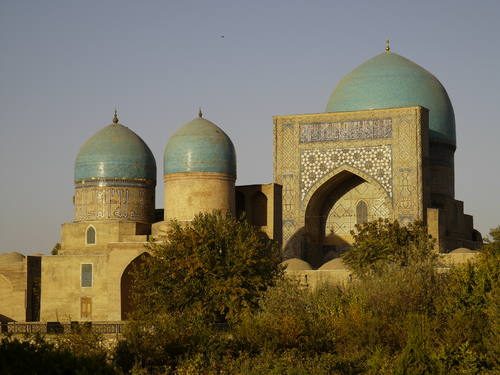ទីម៉ូរីត គឺជាអរិយធម៌ និងជាអាណាចក្រដ៏ធំមួយ ដែលខ្លាំងក្លាបំផុតនៅក្នុងតំបន់អាស៊ីកណ្តាល។ អរិយធម៌មួយនេះគឺកើតចេញពីកុលសម្ព័ន្ឋមួយដែលហៅថា Turko-Mongol ស្ថិតនៅក្នុងតំបន់ Transoxiana។ សព្វថ្ងៃជាតំបន់ដែលស្ថិតនៅក្នុងបណ្តាប្រទេសដូចជា អ៊ូសបេគីស្ថាន តាជីគីស្ថាន កាហ្សាក់ស្ថានខាងត្បូង និងកៀហ្ស៊ីស៊ីស្ថានខាងត្បូង។
អរិយធម៌ទីម៉ូរីតនេះ បានក្លាយជាអាណាចក្រដ៏ធំ ដែលមានផ្ទៃដីគ្រប់គ្រងស្ទើតែទាំងស្រុងនៃអាស៊ីកណ្តាល និងគ្រប់គ្រងផ្នែកខ្លះនៃប្រទេសរូស៊ី និងឥណ្ឌាដែរ។ នៅអំឡុងដើមស.វ.ទី ១៤នៃគ.ស. អាណាចក្រទីមេរីត ចាប់ធ្វើការពង្រីកទឹកដី ដោយធ្វើសង្រ្គាមទៅលើបណ្តាប្រទេសក្បែរៗខាង រួមមានចិន ស៊ីរី រហូតដល់អ៊ីរាក់ អ៊ីរ៉ង់ជាដើម។

រាជធានីនៃអាណាចក្រនេះមានឈ្មោះថា Samarqand ដែលសព្វថ្ងៃស្ថិតនៅក្នុងប្រទេស អ៊ូសបេគីស្ថាន។ Samarqand គឺទីក្រុងដ៏សំខាន់មួយក្នុងចំណោមបណ្តាទីក្រុងផ្សេងៗទៀតនៅក្នុងអាណាចក្រនេះ និងជាតំបន់ដ៏ចំណាស់បំផុតនៅក្នុងតំបន់អាស៊ីកណ្តាលដែរ។ នៅទីនេះ គឺមានសំណង់ស្ថាបត្យកម្មសំខាន់ៗជាច្រើន ដែលបង្ហាញអំពីរចនាបថ សិល្បៈនៃអរិយធម៌ទីម៉ូរីត។ សំណង់ស្ថាបត្យកម្មទាំងនោះ គឺភាគច្រើនទទួលឥទ្ឋិពលពីសិល្បៈ វប្បធម៌ អារ៉ាប់ (Ottoman)។ ការទទួលឥទិ្ធពល គឺនៅពេលដែលអរិយធម៌ទួគស្ថិតនៅក្រោមសម័យកាលអូតូម៉ង់។ ឥទ្ធិពលនៃសិល្បៈ ស្ថាបត្យកម្ម នៃអរិយធម៌ទីម៉ូរីត គឺលាតសន្ឋឹងពីតំបន់ Anatolia រហូតដល់ប្រទេសឥណ្ឌា។

សំណង់ស្ថាបត្យកម្មសំខាន់ជាងគេនៅក្នុងអរិយធម៌ និងអាណាចក្រទីម៉ូរីត គឺជាសំណង់ព្រះវិហារបែបសាសនាអារ៉ាប់ ដែលហៅថា Mosque។ ព្រះវិហារក្នុងអរិយធម៌នេះកសាងមានដំបូលខ្ពស់ៗ មានទំហំធំ ដែលហៅថា large bulbous double domes និងរួមផ្សំជាមួយនឹងសិល្បៈគំនូរនៅលើវិហារដ៏សំបូរបែប ដែលឃើញមាននៅបណ្តាព្រះវិហារនៅ ក្នុងប្រទេស អ៊ូសបេគីស្ថាន និងតាជីគីស្ថាន។


ចំពោះគំនូរទាំងនោះភាគច្រើន គឺគូរទាក់ទង នឹងការគោរពប្រតិបត្តិអំពីសាសនាអ៊ីស្លាម ជាមួយនឹងការឱ្យតម្លៃនៃស្រ្តីផងដែរ។ គួរបញ្ជាក់ដែរថា ជនជាតិទីមើរីតនេះ គឺពូកែខាងធ្វើសង្រ្គាម។ អរិយធម៌ និងអាណាចក្រទីម៉ូរីត ត្រូវបានដួលរលំនៅអំឡុងពាក់កណ្តាលស.វ.ទី១៦។ រាល់ទន្និន័យទាំងអស់ដែលបានបង្ហាញខាងលើ និងតាមរយៈសំណង់ស្ថាបត្យកម្ម សិល្បៈដែលបានបន្សល់ពីអរិយធម៌នេះ បានបង្ហាញថា អរិយធម៌ទីម៉ូរីតត្រូវបានគេស្គាល់ថាជាអរិយធម៌ដែលមានឥទិ្ធពលខ្លាំងក្លានៅក្នុងអាស៊ីកណ្តាលដែលមានអាយុកាល ចាប់ពីឆ្នាំ១៣៧០នៃគ.ស. និងត្រូវបានដួលរលំនៅឆ្នាំ១៥០៧នៃគ.ស. ពោលគឺមានរយៈពេលត្រឹមតែ ២ស.វ.តែប៉ុណ្ណោះ។ យើងក៏អាចដឹងអំពីទំនាក់ទំនងរវាងអរិយធម៌ដែលស្ថិតនៅក្នុងតំបន់អាស៊ីកណ្តាលជាមួយនឹងតំបន់មជ្ឈឹមបូព៌ាជាដើម តាមរយៈឥទ្ឋិពលសិល្បៈ និងវប្បធម៌ផ្សេងៗជាដើម៕
——————————————-
Timurids Civilization
Timurids is one of the most powerful civilizations and empires in Central Asia. This civilization originated from a tribe called Turko-Mongol in the Transoxiana region. Today it is located in countries such as Uzbekistan, Tajikistan, southern Kazakhstan, and southern Kyrgyzstan.
This Timurids civilization became a vast empire that controlled almost all of the Central Asia region and controlled parts of Russia and India. During the early 14th century. Timurids began to expand its territory by waging war on neighboring countries, including China, Syria, Iraq, Iran, and so on.
The capital of this empire is Samarqand, which is now in Uzbekistan. Samarqand is one of the most important capitals in the empire and the oldest in Central Asia. In addition, it contained some of the most important architectural structures that represent the artistic style of the Timurids civilization. The architecture is largely influenced by art culture from Arabia (Ottoman). Influence came when Turkic civilization was under the Ottoman period. The influence of the architectural art of the Timurids civilization extends from Anatolia to India.
The most important architectural structure in the Timuds civilization and empire was the Arab-style mosque. The temples in this civilization were built with large roofs called large bulbous double domes and combined with the rich painting on the temples found in churches in Uzbekistan and Tajikistan.
Most of the paintings are related to the observance of Islam with the values of women. It should be noted that this Timurids is good at war.
The Timurids civilization and empire collapsed during the middle of the 16th century. All the data presented above and through the architectural and artistic remains of this civilization indicated that the Timurids civilization is known as one of the most influential civilizations in Central Asia dating back to 1370 AD and was collapsed in 1507 AD. That is, it lasted only 2 centuries. We can also learn about the relationship between civilizations in Central Asia and the Middle East through the influence of art and culture.
អត្ថបទដើម៖ លោក អេង តុលា






